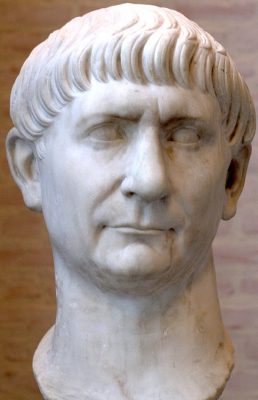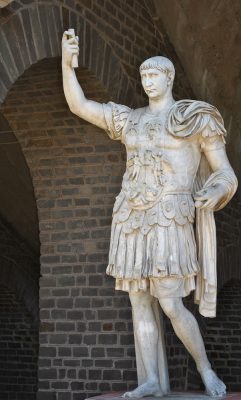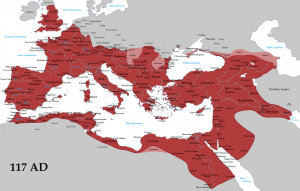Marcus Ulpius Traianus, better known as Trajan, ruled Rome as emperor from 98 until 117. He was born on September 15, 53 CE, and died in Selinus, Cilicia (now Turkey) on August 8th or 9th, 117. Aside from his given name, he was also known as Caesar Divi Nervae Filius Nerva Traianus Optimus Augustus or Caesar Nerva Traianus Germanicus.
Trajan was regarded as a benevolent monarch. While he was Emperor, he implemented many community-beneficial projects, such as improving the city’s aging road infrastructure, building aqueducts, and expanding the port of Ostia. He tried to broaden the empire’s frontiers eastward, started a vast construction project, and increased social assistance in the process. Furthermore, he was a highly effective general, having won three important campaigns against the Dacians and the east, resulting in the Roman Empire reaching its most ideal size to that point. Historians see Trajan as a wise emperor; however, his true passion was battle, and he was highly talented at it.
Early Life
Trajan’s youth is unknown, but he most likely grew up in Rome or another military base with his father. He served for ten years as a legionary staff tribune. His praetorship qualified him to lead a legion in Spain in 89. The governor of Upper Germany ordered him to the Rhine to quell an insurrection against Domitian. For his efforts, Trajan was appointed to one of the two consulships, which remained the most prominent offices long after the empire’s fall.
The Senate accepted Nerva after Domitian’s death. At the same time, his election represented a rejection of Domitian’s tyranny and the restoration of the emperor-senate collaboration that had marked Vespasian’s rule. In October 97, Nerva adopted Trajan as his successor, who he had previously appointed governor of Upper Germany and who seemed to have the support of both the army and the Senate. Trajan was proclaimed emperor by the military and the Senate after the death of Nerva on January 27 or 28, 98. Throughout his reign, Trajan stayed faithful to Pompeia Plotina, whom he married before becoming emperor. He took in Hadrian, his cousin, given the fact that their marriage was barren.
Domestic Policies
There are also significant differences in how Nerva and Trajan ruled; Trajan was a far more active ruler than Nerva had been throughout his brief tenure. He waited on the Rhine and Danube rivers for about a year, perhaps preparing for a campaign into Dacia or restoring discipline and building fortresses. As soon as he returned to Rome in 99, he treated the Senate with respect and kindness. He was very kind to the people of Rome. He gave them a lot of money and made it easier for the state to feed the poor people who lived there. He gave back the money that cities had traditionally given to emperors when they became emperors. He did this for Italy and the rest of the country. He also cut taxes and may have been the person who came up with public funds for poor children in Italian cities.
Moreover, In provinces, Trajan strived to choose competent and honest officials. He dispatched one to Bithynia-Pontus, an area on Asia Minor’s northern coast. The burgeoning Christian cult was a topic of Trajan and Pliny conversations. It is preserved in the 10th volume of Pliny’s correspondence, which covers his two years as governor. Their discussions are essential since the Provincial administration relies on them.
Aqueducts and roads were also built or funded by Trajan, as were wastelands reclamation and ports in the provinces and Rome. Some significant examples can be found in Spain, North Africa, the Balkans, and Italy. Rome benefited greatly from Trajan’s efforts. A new aqueduct brought in water from the north. Apollodorus of Damascus established Esquiline Hill’s new forum. The centerpiece was a colossal equestrian statue of the Emperor in a porticoed square.
Building Projects
The Trajan Forum and Trajan’s Column were two of Trajan’s greatest gifts to Rome, and they remained such for many years. The Dacian treasury provided the funding for the Trajan Forum, which opened in 112 CE. There were about one million inhabitants in Rome by Trajan and Nerva’s time; thus, the city needed a new forum for politics, business, and religion. There is a forum between the Quirinale and the Capitoline. Great halls and offices ringed the area, surrounded by two semi-circular six-story buildings. It was in the year 113 CE when Trajan’s Column was inaugurated. The 100-foot column was embellished with friezes portraying his battles with the Dacians. A stairwell led to a viewing platform at the top of the column, where a Trajan monument stood until a St. Peter statue replaced it.
Military Campaigns
His contributions to civil society were significant, but they were hardly groundbreaking. He is well-known for his opposition to Augustus’s and his successors’ policy of not expanding Roman borders. Not much happened during his first year on the Rhine-Danube border. In 101, Domitian had been compelled to flee Dacia by Decebalus, the mythical ruler of the territory. In response, he launched an invasion of Dacia in 101. During two military operations (101–102 and 105–106), Trajan took Sarmizegethusa, the capital of the Dacians; Decebalus escaped captivity by committing suicide. Trajan established a new Dacia province north of the Danube in the Carpathian Mountains. As a result, Roman settlers found gold and salt mines in the area.
The Parthians, Rome’s eastern foe, were the target of Trajan’s second major campaign in which Trajan was victorious. Nabataean kingdom, east, and south-east of Juda, was captured by one of his generals in AD 105/106. Armenia’s pro-Roman ruler was ousted by the Parthians around 110, and Trajan campaigned in 113/114 to restore him. During this time, Trajan built the King’s Highway along the traditional caravan route. Bostra, a new Roman province in Arabia, was connected to the Red Sea by the Via Nova Traiana.
Death and Succession
Antioch was devastated by an earthquake in late 115, but Trajan escaped unscathed. Newly gained territories and Jewish settlements in the eastern provinces were overrun by rebellions in 116. He left Antioch for Rome because he was unhappy and sick. At the age of 64, he died in Selinus (now Selindi), on Asia Minor’s southern coast. A state funeral was held in Rome and he was buried at the foot of his column.
Before his death became public, it was discovered that Trajan had adopted Hadrian, who had married his beloved niece in the year 100. A few years before he died, Trajan had already appointed Hadrian as governor of Syria, where he was in charge of the Parthian army’s logistical assistance, despite their differences in temperament. Trajan, on the other hand, did not accept him as his own or appoint a successor. Hadrian’s adoption was announced by Plotina, Trajan’s wife and empress of Rome.


